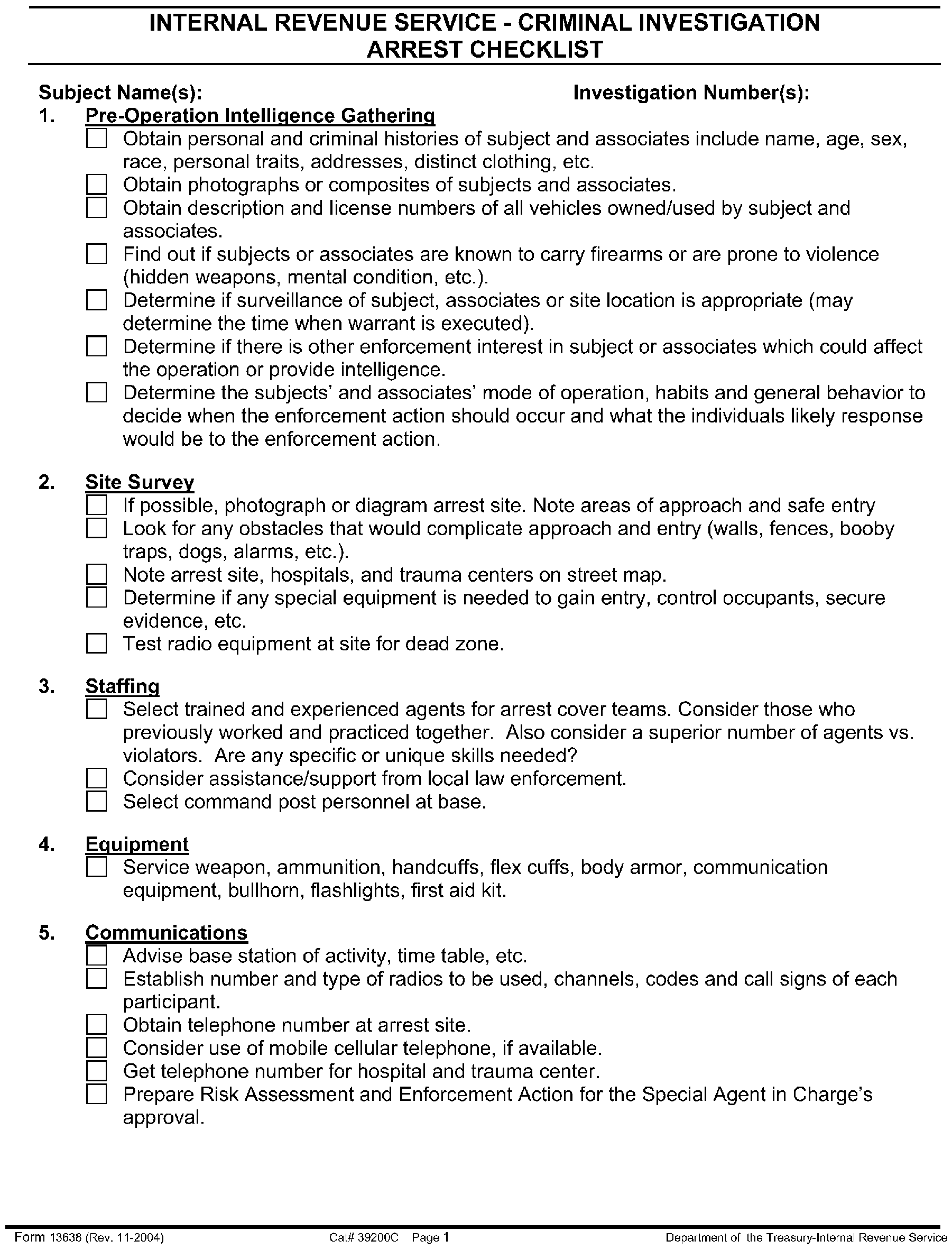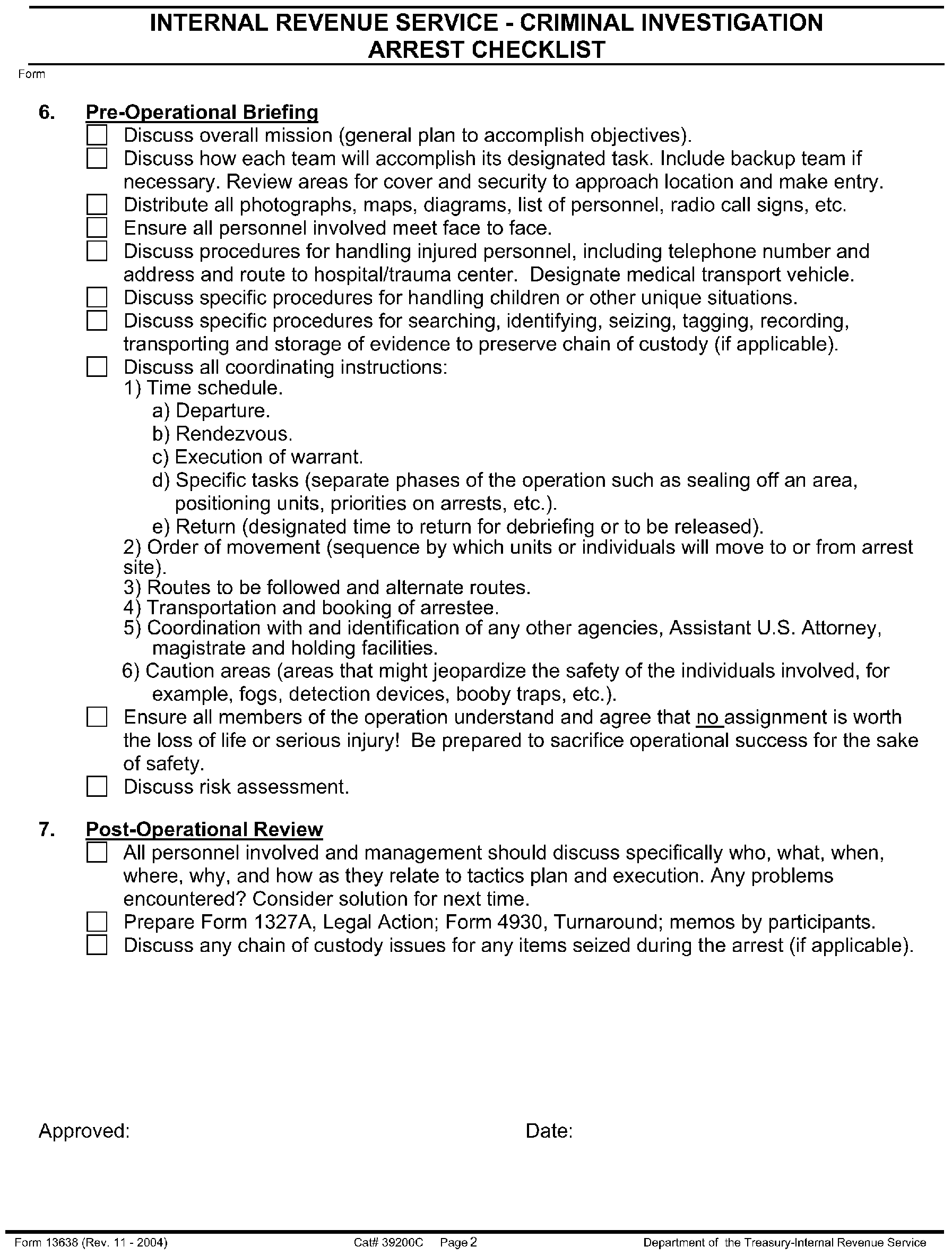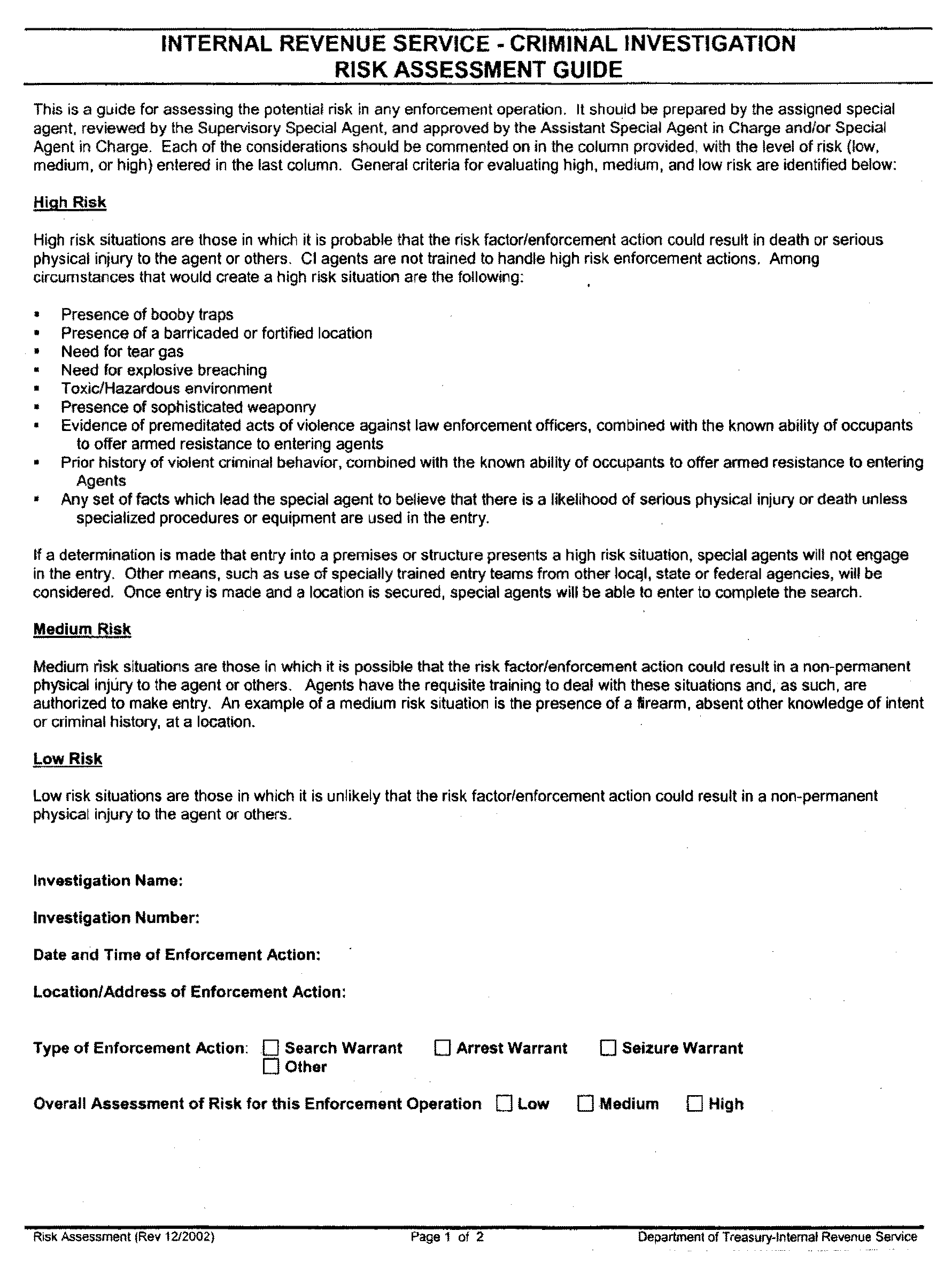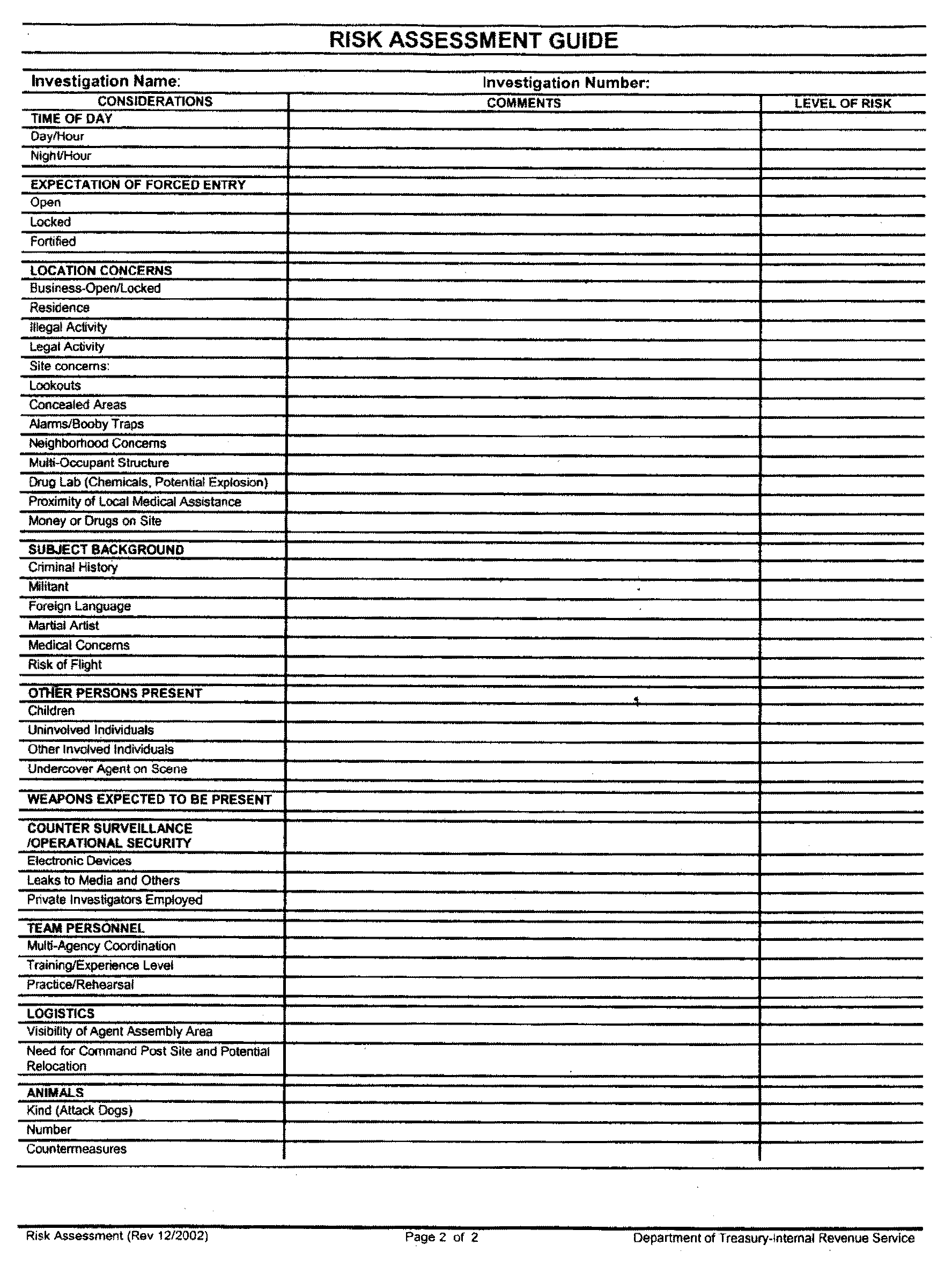- 9.4.12 Arrests
- 9.4.12.1 Program Scope and Objectives
- 9.4.12.1.1 Background
- 9.4.12.1.2 Authority
- 9.4.12.1.3 Roles and Responsibilities
- 9.4.12.1.4 Program Management and Review
- 9.4.12.1.5 Program Controls
- 9.4.12.1.6 Acronyms and Terms
- 9.4.12.1.7 Related Resources
- 9.4.12.2 General Information
- 9.4.12.3 Authority to Arrest
- 9.4.12.3.1 Statutory Authority to Arrest
- 9.4.12.3.1.1 Arrest Without Warrants
- 9.4.12.3.2 Non-Statutory Authority to Arrest
- 9.4.12.3.1 Statutory Authority to Arrest
- 9.4.12.4 Definition of Arrest
- 9.4.12.4.1 Elements of an Arrest
- 9.4.12.5 Securing an Arrest Warrant
- 9.4.12.6 Preparation for the Arrest
- 9.4.12.7 Arrests in Forcible Rescue Investigations
- 9.4.12.8 Arrest of a Juvenile
- 9.4.12.8.1 Definition of Juveniles
- 9.4.12.8.2 If a Juvenile is Arrested
- 9.4.12.9 Arrest or Detention of Foreign Nationals
- 9.4.12.9.1 Provisional Arrest Requests
- 9.4.12.10 Arrest Made in Wagering Investigations
- 9.4.12.11 Procedure After Arrest
- 9.4.12.11.1 Custody of the Arrested Person
- 9.4.12.11.2 Search of Arrested Person
- 9.4.12.12 Interview of Persons in Custody
- 9.4.12.13 Processing the Arrested Person
- 9.4.12.13.1 Photographing the Arrested Person
- 9.4.12.13.2 Fingerprinting the Arrested Person
- 9.4.12.13.3 Obtaining a Buccal DNA Cheek Swab from Arrestees
- 9.4.12.14 Hearing Before United States Magistrate
- 9.4.12.15 Reporting the Arrest
- 9.4.12.16 Criminal Investigation Management Information System
- 9.4.12.17 Domestic Fugitives And Wanted Persons
- 9.4.12.17.1 Fugitive and Wanted Person Entries In Treasury Enforcement And Communication System
- 9.4.12.17.2 Sealed Indictments
- 9.4.12.17.3 Bail Jumping
- 9.4.12.17.4 Wanted Circulars
- 9.4.12.18 International Fugitives
- 9.4.12.18.1 INTERPOL Red Notice
- 9.4.12.18.2 Requests for Provisional Arrest with a View Toward Extradition
- 9.4.12.18.3 Canceling INTERPOL Requests for Fugitive Location and Red Notices
- Exhibit 9.4.12-1 Arrest Checklist, Form 13683
- Exhibit 9.4.12-2 Mandatory Notification Countries and Jurisdictions
- Exhibit 9.4.12-3 Suggested Statement to Arrested or Detained Foreign Nationals
- Exhibit 9.4.12-4 Suggested Fax Sheet for Notifying Consular Officers of Arrests or Detentions
- Exhibit 9.4.12-5 Arrest Report, Form 1327-A
- Exhibit 9.4.12-6 Prosecutor's Confirmation of Agreement to Extradite
- Exhibit 9.4.12-7 INTERPOL Red Notice Application Form
- Exhibit 9.4.12-8 Risk Assessment Guide
- 9.4.12.1 Program Scope and Objectives
Part 9. Criminal Investigation
Chapter 4. Investigative Techniques
Section 12. Arrests
9.4.12 Arrests
Manual Transmittal
July 01, 2025
Purpose
(1) This transmits revised IRM 9.4.12, Arrests.
Material Changes
(1) IRM 9.4.12, revised to comply with Executive Orders and Office of Personnel Management (OPM) memorandums regarding diversity, equity, inclusion (DEI) gender, or related subject matter.
(2) IRM 9.4.12.11.2 (2), term gender replaced with sex.
Effect on Other Documents
This IRM supersedes IRM 9.4.12 dated February 12, 2025.Audience
Criminal InvestigationEffective Date
(07-01-2025)Guy A. Ficco
Chief, Criminal Investigation
-
Purpose: This section provides detailed guidance to special agents on their roles and responsibilities when planning, executing and after making an arrest. This section also provides information regarding domestic fugitives, wanted persons, and international fugitives.
-
Audience: All Criminal Investigation (CI) employees.
-
Policy Owner: Director, Asset Recovery and Investigative Services (ARIS).
-
Program Owner: ARIS.
-
Primary Stakeholders: Director, ARIS, and Director, International Operations (IO).
-
Contact Information: To make changes to this IRM section email CIHQIRM@ci.irs.gov.
-
Special agents may request and execute an arrest warrant. The special agent will be responsible for recommending to the Special Agent in Charge (SAC) the merits of Criminal Investigation (CI) requesting the issuance and execution of an arrest warrant. Upon the concurrence of the SAC, the special agent will forward the request to the attorney for the government. In approving requests, the SAC will consider the strict time provisions of the Speedy Trial Act. In other circumstances, CI will execute an arrest warrant only upon the request of the attorney for the government.
-
The following will be discussed in this IRM section:
-
General Information.
-
Authority of Arrest.
-
Definition of Arrest.
-
Securing an Arrest Warrant.
-
Preparation for Arrest.
-
Arrest in Forcible Rescue Investigations.
-
Arrest of Juveniles.
-
Arrest or Detention of Foreign Nationals.
-
Arrest made in Wagering Investigations.
-
Procedures after Arrest.
-
Interview of Persons in Custody.
-
Processing the Arrested Person.
-
Hearing before a U.S. Magistrate.
-
Report the Arrest.
-
Domestic Fugitives and Wanted Persons.
-
International Fugitives.
-
-
The statutory authority for special agents to make arrests is contained in 26 USC 608, as amended.
-
See IRM 9.1.2, Authority for the delegated authority relating to IRM 9.4.2, Arrests.
-
The Director, ARIS is responsible for developing, maintaining, and overseeing this IRM and ensuring compliance with current policies and procedures.
-
The Director, ARIS will:
-
Review this IRM annually.
-
Update this IRM when content is no longer accurate and reliable to ensure employees correctly complete their work assignments and for consistent administration of the tax laws.
-
Incorporate all permanent interim content into the next revision of this IRM section prior to the expiration date.
-
-
The Director, ARIS, will review and oversee their program as well as ensuring employee compliance with all applicable elements of this IRM.
-
The following table lists the acronyms and terms used throughout this IRM section and their definitions:
Acronym Definition ASAC Assistant Special Agent in Charge ARIS Asset Recovery and Investigative Services CI Criminal Investigation CIMIS Criminal Investigation Management Information System CODIS DNA Index System CT Criminal Tax DOJ Department of Justice FBI Federal Bureau of Investigation Fed. R. Crim. P. Federal Rules of Criminal Procedure HQ Headquarters INTERPOL International Criminal Police Organization INTERPOL-USNCB INTERPOL-U.S. National Central Bureau IO International Operations NCIC National Crime Information Center OIA Office of International Affairs SAC Special Agent in Charge SSA Supervisory Special Agent TECS Treasury Enforcement and Communication System USMC U.S. Marshals Service USNCB IRS U.S. National Central Bureau
-
IRM 9.1.2, Authority.
-
IRM 9.1.3, Criminal Statutory Provisions and Common Law.
-
IRM 9.1.4.8, Directive No. 7 - Emergency Driving.
-
IRM 9.2.3, Use of Force Procedures.
-
IRM 9.4.5, Interviews.
-
IRM 9.9.4, Criminal Investigation Management Information System Data Field.
-
During most investigations, it will be advantageous to wait until after filing information or receiving an indictment to make an arrest. The time limit under the Speedy Trial Act starts to run at the time of an arrest. Arrests should be made only in situations where the investigation would be in jeopardy if an arrest were not made or when an arrest warrant has been issued.
-
Special agents will not normally make warrantless arrests except under exigent circumstances, such as a physical attack on an employee or forcible rescue of seized property in the presence of the special agent (see subsections 9.4.12.3, and 9.4.12.7). An arrest warrant lessens the likelihood of a complaint of false arrest being filed against the arresting special agents.
-
Special agents may request and execute an arrest warrant. The special agent will be responsible for recommending to the SAC the merits of CI requesting the issuance and execution of an arrest warrant. Upon the concurrence of the SAC, the special agent will forward the request to the attorney for the government. In approving requests, the SAC will consider the strict time provisions of the Speedy Trial Act. In other circumstances, CI will execute an arrest warrant only upon the request of the attorney for the government.
-
Special agents have statutory authority to make arrests with or without a warrant.
-
The statutory authority for special agents to make arrests is contained in 26 USC 7608, as amended. This statute enables special agents to:
-
Execute and serve search warrants and arrest warrants, and serve subpoenas and summonses issued under authority of the United States.
-
Make arrests without warrant for any offense against the United States relating to the Internal Revenue laws committed in their presence, or for any felony cognizable under such laws if they have reasonable grounds to believe that the person to be arrested has committed or is committing any such felony.
-
Make seizures of property subject to forfeiture under the Internal Revenue laws.
-
-
An arrest without a warrant is a serious matter and could subject the special agent(s) to civil liability. Therefore, in order for a special agent to make a warrantless arrest, a felony must have been committed in the agent's presence or the agent must reasonably believe the person arrested committed a felony (see subsection 9.4.12.3.1).
-
If the special agent intends to make a warrantless arrest in a tax investigation that still requires Department of Justice (DOJ) approval, the SAC should seek pre-referral advice from DOJ to prevent making an arrest in an investigation that may not be authorized for prosecution. All other investigations, such as money laundering arrests, are approved directly by the attorney for the government after being referred by the SAC.
-
The decision to seek arrest warrants is the responsibility of the attorney for the government. However, DOJ authorization for tax violations is required.
-
The Supreme Court has stated that, in the absence of a statute limiting Federal agents’ power to arrest without a warrant, those agents have the same powers of arrest as a private citizen.
-
A special agent's power to make a warrantless arrest as a private citizen, when valid under state law, is not invalid because the crime is outside the scope of the Internal Revenue laws.
-
Special agents should use extreme caution in acting as a private citizen and should be familiar with the arrest laws of the locality where the arrest occurs.
-
In some states, special agents are granted peace officer status (see IRM 9.1.2, Authority).
-
Arrest means to take custody of a person accused of a crime for the purpose of holding or detaining them to answer a criminal charge.
-
Three basic elements must be present before an arrest is complete:
-
The agents must have the authority to make the arrest.
-
The offender must know that an arrest is intended.
-
The offender must submit to the authority of the agents.
-
-
When making an arrest, special agents should:
-
Announce their official identity to the person being arrested.
-
Display their issued badges and credentials when circumstances permit.
-
Make known to the offender that they are being arrested.
-
Inform the offender of the reason for such action.
-
Take control of the arrestee.
-
-
After the offender submits to the authority of the arresting special agent(s), further resistance or an attempt to escape may constitute another offense.
-
While reasonable force may be employed to affect an arrest, the use of excessive force may subject the special agent to liability for tort damages. Firearms may be used only in accordance with the guidelines in IRM 9.2.3, Use of Force Procedures.
-
The procedures for securing an arrest warrant are dependent upon the following factors:
-
Whether the investigation is a Title 26 violation requiring approval by the DOJ, Tax Division.
-
Whether approval by the DOJ, Tax Division to prosecute the Title 26 violation has occurred or is pending.
-
Local US Attorney policies and attorney for the government preferences regarding obtaining arrest warrants.
-
-
In situations when arrest is appropriate, it is preferable to receive an indictment, prior to the issuance of an arrest warrant. This avoids many problems including the early release of the evidence during preliminary hearings. Such hearings inevitably result in the release of information which otherwise would not have been disclosed until much later.
-
After an indictment, there is no preliminary hearing or probable cause hearing because the grand jury has already determined probable cause. See Federal Rules of Criminal Procedure (Fed. R. Crim. P.) R 5.1.
-
The issuance of bench warrants may be discouraged by attorneys for the government. It is widely believed that such warrants should only be used where there is a genuine flight risk or reason to believe the defendant is a danger to the community. There may be other reasons justifying arrest including planned simultaneous searches which may counterbalance the reluctance of an attorney for the government regarding the issuance of warrants.
-
With the issuance of warrants, there is a concern that the government may appear to be overreaching. Absent a strong basis for a warrant, attorneys for the government may prefer to have the defendant appear for a warrant, via the issuance of a subpoena.
-
The decision to issue an arrest warrant is the responsibility of the attorney for the government.
-
The SAC of the special agent making the arrest should review and approve the Arrest Checklist. See Exhibit 9.4.12-1, Arrest Checklist, Form 13638, as well as the Risk Assessment Guide, Exhibit 9.4.12-8. The risk assessment guide requires the approval of the SAC prior to execution of the arrest warrant. The arrest checklist and risk assessment guide will be maintained in the investigative file (see subsection 9.4.12.15.1).
-
A special agent planning an arrest will ensure the following is addressed:
-
Conducting pre-operation intelligence gathering.
-
Preparing a site survey.
-
Reviewing staffing.
-
Reviewing equipment needs.
-
Reviewing communications.
-
Conducting a pre-operational briefing.
-
Notifying the US Marshals Service and arranging for pre-trial detention, if applicable.
-
Contacting family services if minors will be present.
-
Contacting animal control if animals will be left unattended after the arrest.
-
-
Special agents will not use force to accomplish a recovery of property in forcible rescue investigations; however, they may make an immediate arrest (without an arrest warrant) when the forcible rescue takes place in their presence.
-
Special agents should consider all available options before making the decision to arrest. Specifically, the special agent should:
-
Advise the person attempting or making the rescue that they are about to commit or is committing a crime.
-
Consider the IRS’ likelihood of recovering the asset(s) being rescued (e.g., currency or other readily disposable assets versus machinery, automobiles, etc.).
-
-
In many instances, withdrawal from the scene and applying for an arrest warrant may be the best alternative, particularly in a volatile situation.
-
Regardless of the decision, if a forcible rescue occurs, the facts and circumstances should be immediately reported to the SAC. If an arrest is not made, the SAC will discuss the issue with Criminal Tax (CT) Counsel. If the decision is made to obtain an arrest warrant, the request will be made to the attorney for the government.
-
Special agents should not become involved in emergency driving in forcible rescue investigations. Sufficient facts will normally exist for special agents to subsequently obtain an arrest warrant without endangering the lives of others by engaging in emergency driving (IRM 9.1.4.8, Directive No. 7 - Emergency Driving).
-
In the event a physical attack is made upon an IRS employee, special agents may arrest the attacker using only such force as is reasonable and necessary in accordance with the provisions outlined in IRM 9.2.3, Use of Force Procedures.
-
Generally, special agents will not have occasion to arrest a juvenile for a violation of the Internal Revenue laws.
-
For the purpose of this provision, and as defined in 18 USC 5031, a juvenile is a person who has not attained their 18th birthday, or for the purpose of proceedings and disposition for an alleged act of juvenile delinquency, a person who has not attained their 21st birthday; and juvenile delinquency is the violation of a law of the United States committed by a person prior to their 18th birthday which would have been a crime if committed by an adult.
-
If special agents are ordered or requested to serve an arrest warrant upon a juvenile, or if it is deemed necessary to arrest a juvenile without a warrant, the special agents must comply with the procedures set forth in 18 USC 5033, Custody Prior to Appearance Before Magistrate. This section provides the following:
-
Whenever a juvenile is taken into custody for an alleged act of juvenile delinquency, the arresting officer shall immediately advise such juvenile of their legal rights, in language comprehensive to a juvenile, and shall immediately notify the Attorney General and the juvenile’s parents, guardian, or custodian of such custody.
-
The arresting officer shall also notify the parents, guardian, or custodian of the rights of the juvenile and of the nature of the alleged offense.
-
The juvenile shall be taken before a US magistrate immediately. In no event shall the juvenile be detained for longer than a reasonable period of time before being brought before a US magistrate.
-
-
A foreign national is defined as any person who is not a United States citizen.
-
Treaty obligations of the United States require Federal law enforcement officers to notify certain foreign authorities when foreign nationals have been arrested or detained in the United States.
-
To ensure that Americans abroad obtain the treatment to which they are entitled, it is essential that the United States not violate any of its obligations under these treaties.
-
When special agents arrest or otherwise detain a foreign national, the arresting special agent must promptly inform the detainee of their right to have their government informed of such event and that they have a right to consular access. In most cases, the foreign national has the option to decide whether to have consular officials notified. Some agreements with certain countries require mandatory notification when their nationals are arrested or detained. See Exhibit 9.4.12-2, Mandatory Notification Countries and Jurisdictions. In these instances, the foreign national has no choice regarding notification and the arresting or detaining special agent will notify the consulate or the embassy of the situation without delay. See Exhibit 9.4.12-3, Suggested Statements to Arrested or Detained Foreign Nationals, which provides suggested statements that may be used to advise foreign nationals of consular rights.
-
If the detainee requests notification, the arresting or detaining special agent must ensure that notification is immediately given to the nearest consulate or embassy of the detainee's country. The physical addresses and telephone/fax numbers of the foreign consular offices in the United States can be obtained from the internet site, http:www.state.gov.
-
Foreign consular officers have the right to visit their nationals who are in prison, custody, or detention, to converse and correspond with them and to arrange for their legal representation, unless the person being held expressly opposes these actions. They must refrain from acting on behalf of a foreign national if the foreign national opposes their involvement. In addition, consular officers may not act as attorneys for their nationals.
-
Special agents should keep written records sufficient to show compliance with the notification requirements. These records should show all notifications to foreign consular representatives. In addition, in cases in which notification is at the discretion of the detained foreign national, these records should show that the foreign national was informed of the option of consular notification, the date when the foreign national was so informed, and whether or not the foreign national requested that consular officials be notified. If confirmation of receipt of notification is available, it should be saved if possible. See Exhibit 9.4.12-4, Suggested Fax Sheet for Notifying Consular Officers of Arrests or Detentions, for an appropriate document to record compliance with the notification requirements.
-
A provisional arrest request is the process that DOJ uses to extradite a fugitive located in a foreign jurisdiction.
-
Questions regarding provisional arrest requests should be directed to CI's International Criminal Police Organization (INTERPOL) Representative.
-
In situations where an arrest is made in a wagering occupational tax investigation, the SAC will ensure that related investigations involving any wagering excise tax investigations and those Title 18 violations delineated in IRM 9.1.3, Criminal Statutory Provisions and Common Law, committed in contravention of the Internal Revenue laws are completed promptly. All related violations can then be prosecuted concurrently, in order to comply with the strict time provisions of the Speedy Trial Act and to avoid dual prosecution problems.
-
After the arrested person is in custody, special agents must follow certain processing procedures.
-
Special agents who make an arrest are responsible for the safety and custody of the arrested person. Special agents may detain the arrested person for a reasonable time until they can conveniently and safely take them before a U.S. magistrate.
-
When the circumstances prevent an immediate hearing, the arrested person may be taken to the nearest police station, U.S. Marshals Office, or local detention center/jail. The detention facility should be approved for custody of Federal prisoners, if feasible. The arrested person will be held as a Federal prisoner at the facility until arrangements are made for their hearing.
-
However, the person arrested shall not be detained longer than absolutely necessary before being granted a hearing.
-
Special agents must conduct a thorough search of the arrested person. They should search for weapons, contraband, means of escape, and instruments used in the commission of the crime.
-
A reasonable attempt should be made to have a special agent of the same sex as the arrested person present to conduct the search of the body and clothing for weapons and evidence. Safety is paramount at all times along with professionalism, common sense, and maintenance of human dignity.
-
When a subject is arrested and has a passport, the passport may be retained by the law enforcement agency for evidentiary purposes. However, when it is no longer needed for the law enforcement purpose and the person is still in custody or subject to a bond or parole, the passport must be returned to the Department of State at the following address:
Department of State Office of Legal Affairs for Passport Services 2100 Pennsylvania Ave NW, 3rd Floor Washington, DC 20037 Telephone: (202) 663-2662; Fax: (202) 663-2654
-
Special agents will not delay an arrested person’s appearance before a US Magistrate for the purpose of an extensive interview or attempting to obtain a statement. However, if the statement can be obtained without unnecessary delay and if the person arrested is willing to make a statement, it should be recorded subject to the procedures and safeguards outlined in IRM 9.4.5, Interviews.
-
IRM 9.4.5 is also applicable to interviews of arrested persons in custody of local authorities.
-
Prior to questioning a person arrested by local or state authorities, special agents should determine whether the local authorities gave an adequate constitutional warning.
-
If no warning was given by local authorities, or if their warning was incomplete, a standard pre-interview warning by the special agents may not be sufficient to assure the admissibility of statements made by the arrested person.
-
In this situation, the special agents may have to take additional precautions to dispel the impression that the interviews by local authorities and by the special agents are really a single, continuous period of questioning.
-
This may be accomplished by:
-
Allowing a reasonable amount of time to lapse between the local law enforcement interview and questioning by the special agents.
-
Explaining to the arrested person the distinction between the special agent's interest in the investigation and the local police's interest.
-
Obtaining an affirmative waiver of rights reflecting the arrested person's understanding of these distinctions.
-
-
CT should be consulted to resolve questions concerning the adequacy of constitutional warnings given by local or state authorities and to assist special agents in selecting appropriate measures to counteract any apparent deficiencies.
-
Whenever feasible, special agents should obtain fingerprints and photographs of the arrested person. If adequate equipment and skilled personnel are available, the fingerprinting and photographing should be done by CI. Otherwise, it may be done by an officer of any other law enforcement agency having the necessary equipment. In addition, special agents perfecting arrests will have to obtain a Buccal DNA cheek swab from the arrestee.
-
The arrested person will be photographed full-face view and side view. In the full-face view, a card should be placed below face level, setting forth the office where the photograph is taken, the date, and the arrested person's name. The following information should be shown on the reverse side of the photographs:
-
The name of person arrested,
-
Known aliases,
-
Current address,
-
Investigation number, if available,
-
Social security number,
-
Date of birth,
-
Violations charged,
-
Weight,
-
Height,
-
Race,
-
Color of eyes,
-
Build,
-
Color of hair,
-
Complexion,
-
Scars and marks,
-
Nationality and alien registration number,
-
Passport number.
-
-
Two sets of fingerprint cards will be prepared for each arrested person on Federal Bureau of Investigation (FBI) Form FD–249, Fingerprint Card (white card with red ink). Each field office has been provided with pre-printed fingerprint cards showing the agency’s name and the originating agency identifier (ORI) number.
-
The photographs described in subsection 9.4.12.13.1, Photographing the Arrested Person, will be attached to one set of fingerprint cards; this set will be retained in the investigative file. The second set of fingerprint cards will be mailed directly to the Identification Division, Federal Bureau of Investigation, Washington, DC, 20537–9700.
-
Additional pre-printed fingerprint cards showing the agency’s name and ORI number can be obtained from the FBI by completing FBI Form 1–178 (Rev. 5–18–78), Requisition for Ordering Identification Supplies. Completed forms are to be mailed to the Identification Division, FBI, Washington, DC, 20537–9700.
-
Special Agents will obtain a Buccal DNA cheek swab from the arrestee before they can be processed by the U.S. Marshals. The collected Buccal DNA cheek swab will be submitted to the FBI laboratory. The FBI laboratory is responsible for ensuring the DNA profile is entered into the combined DNA Index System (CODIS). The U.S. Marshals will only perform Buccal DNA cheek swab on their arrestees.
-
Field Offices will be responsible for ordering Buccal DNA cheek swab kits directly from the FBI and ensuring all agents are trained in taking a cheek swab. Training and Buccal DNA cheek swab supplies can be obtained from the FBI websites listed below:
-
A special agent who makes an arrest, whether with or without an arrest warrant, must take the arrested person, without unnecessary delay, before the nearest available US magistrate or other nearby officer empowered to commit persons charged with offenses against the laws of the United States. If the arrest was without an arrest warrant, a complaint must be filed (see Fed. R. Crim. P. R5).
-
Special agents must immediately inform their Supervisory Special Agent (SSA) of any arrests they make. The SSA will, in turn, immediately report such information to the Assistant Special Agent in Charge (ASAC)/SAC.
-
When it is necessary to make an arrest prior to consulting the attorney for the government, they shall be notified promptly of the arrest, advised fully of the facts in the investigation, and requested to represent the government in the preliminary examination before the US magistrate.
-
In addition to the reporting procedures set forth in paragraphs 1 and 2 above, the special agent will prepare a Form 1327–A, (see Exhibit 9.4.12-5, Arrest Report, Form 1327-A) before the close of the next business day following the arrest. Upon approval by the SAC, the following distribution will be made:
-
Original to special agent.
-
One copy to Field Office Public Affairs Officer.
-
One copy to CT Counsel.
-
One copy to the Director, International Operations (SE:CI:GO:IO), if the individual arrested is a foreign national.
-
-
If the arresting special agents believe valid reasons exist for opposing release of the arrested person on personal bond, these reasons should be brought to the attention of the attorney for the government prior to the bail hearing. The attorney for the government may request that the special agent prepare a Bail Reform Act Form No. 1, AO–201, for use at the hearing. The form is available at the Clerk's Office for each US district court. The original will be furnished to the attorney for the government and a duplicate will be retained in the investigative file.
-
In all instances where a CI special agent is the arresting agent, the following documents will be maintained by the originating group:
-
Signed Arrest Warrant or Complaint (with signed Affidavit).
-
Enforcement Action Review Form.
-
Arrest Checklist.
-
Risk Assessment Guide.
-
Enforcement Action Plan.
-
Post Enforcement Operation Summary.
-
Form 1327- A Arrest Report.
-
-
The above documents must be maintained electronically in the originating group's administrative investigation file. While such documents will ideally be kept in an electronic format, it is understood that paper documents may be more practical in some instances. Regardless of the format, these documents should be readily accessible for investigative purposes and properly "retired" (i.e., stored) with related investigation files when the investigation is closed.
-
In addition to the documents maintained in the group files, a copy of only the Enforcement Action Review Form must be maintained in the SAC's administrative files. These "centralized" files may also be electronic, paper, or a combination thereof. However, they must be readily accessible indefinitely for internal or external review.
-
In all instances where a CI special agent is a participant in another agency's arrest warrant, the Enforcement Action Review Form is the only document that is required to be maintained in the SAC's electronic administrative files.
-
Arrests are to be reported in the Criminal Investigation Management Information System (CIMIS) (see IRM 9.9.4, IRM 9.9.4, Criminal Investigation Management Information System Data Field).
-
When it is determined that a subject is a fugitive or wanted person, the special agent must request an entry be made by Headquarters (HQ) to Treasury Enforcement and Communication System (TECS) and by the US Marshals Service (USMC) to FBI's National Crime Information Center (NCIC). In addition, a current photograph of the fugitive should be submitted in electronic format (jpg) to the *CI HQ-TECS mailbox. Wanted circulars may be requested by the field office SAC, to the US Marshals Service, but only on fugitives who are charged with felony violations (see IRM 9.4.12.17.4).
-
Entry of Federal fugitives in the NCIC Wanted Person File and TECS should occur within 24 hours after:
-
Issuance of an arrest warrant.
-
The decision has been made as to whether and how far to go for extradition. Exceptions to this rule would be if imminent (within five days) arrest is expected or other clear, identifiable operational reasons would preclude immediate entry (e.g., insufficient descriptive data resulting in a "John Doe" warrant). Immediate entry must be made when a caution notation-a warning that the fugitive is dangerous, suicidal, or has a serious medical condition-is indicated. Any exceptions to delayed entry in NCIC must be minimized and documented.
-
-
Modifications, clearing, locating, or cancellation of a fugitive's NCIC and TECS records must occur within 24 hours after receipt of the information prompting the change.
-
When information is received in any CI office that a fugitive or wanted person has been apprehended, for any reason whatsoever, the arresting authorities will be requested to hold the individual for further action by the IRS or the person holding the warrant or commitment papers. The CI official who learns that a fugitive or wanted person has been apprehended shall telephone the 24-hour number of the field office where the individual is wanted, and the Director, ARIS. This is to ensure that the person holding the warrant or commitment papers can be immediately notified of the detention. In those instances where the above officials are notified telephonically, the notifying CI official will follow up with a written notification to them. The special agent participating in, verifying, or making the arrest will promptly update CIMIS. The SAC, of the field office where the fugitive is wanted, shall follow up to ensure appropriate handling of the fugitive. Thereafter, they shall submit a brief report to the Director, ARIS, detailing the action taken. This report will also include a request to delete the TECS and NCIC entry. (Steps should also be taken to cancel any existing Wanted Circular with HQ or USMC regarding the fugitive.)
-
When the SAC of the field office where the fugitive is wanted learns that the fugitive is located in another field office, they will immediately notify the SAC of the other field office as to the location of the fugitive and will furnish all available information necessary for the apprehension of the fugitive. Where such notification is made by telephone with the request that the fugitive be arrested, confirmation should immediately follow by fax, so that the appropriate attorney for the government may have a documented request upon which to act. After the arrest has been made, the SAC shall submit a memorandum regarding cancellation in TECS to the Director, ARIS (SE:CI:GO:ARIS), and notify the US Marshals Service to remove the fugitive from NCIC. Both of these actions must be documented in the investigative file.
-
A supplemental report shall be prepared by the special agent when an individual fails to surrender to the court on the date stipulated. The report should set forth the facts in the investigation and recommend (if appropriate) that legal proceedings be instituted charging the individual with a violation of 18 USC 3146, Penalties for Failure to Appear. This action may materially aid CI to return, by extradition, individuals who have fled the country because a violation of 18 USC 3146 is usually an extraditable offense.
-
All entries into TECS will be made by HQ. The NCIC entries will be made by the local US Marshals Service. A written request must be received within 24 hours from the date of warrant, with a copy of the arrest warrant by the Director, ARIS, and the local office of the US Marshals Service. One copy of the request is to be retained in the field office’s investigative file. In urgent situations, the request memorandum and attachment may be faxed or e-mailed to HQ and the US Marshals Service. The request memorandum can be accessed through Document Manager under the fugitive folder, or requested from HQ. The request should contain the following to the extent available (these procedures should also be followed for requesting modifications):
-
Name and investigation number*,
-
Alias,
-
Race*,
-
Sex*
-
Height*,
-
Weight*,
-
Color of hair*,
-
Color of eyes,
-
Description of any identifying scars, marks and tattoos,
-
Date of birth*,
-
Place of birth,
-
Social security number+,
-
Passport number,
-
Last known address,
-
Nationality,
-
If a naturalized US citizen: date, place, and certificate number,
-
Occupation,
-
Criminal violation with which subject is charged*,
-
Date of warrant*,
-
Warrant number,
-
Type of warrant -- Bench, Magistrate, etc,
-
Agency holding warrant -- US Marshal, IRS-CI, etc.,
-
Any information as to whether the subject is considered dangerous, owns or possesses firearms, has suicidal tendencies, or has previously escaped custody. (Please ensure that a statement of caution and reason for the caution is provided when applicable.),
-
Drivers license number, year of expiration and issuing state+,
-
License number of vehicle, aircraft, or vessel, including year and state, owned or used by subject+,
-
Description of vehicle, aircraft, or vessel,
-
Associates of subject,
-
FBI number,
-
A primary and secondary name and telephone number of CI personnel to contact when subject is apprehended. A 24-hour district telephone number must be included.
-
-
If a decision is made to issue a wanted circular, the memorandum to the US Marshals Service must contain a request to do so, and include the following additional information:
-
Fingerprints and fingerprint classification (if fingerprints are not readily available, any information that might help locate them will prove beneficial, e.g, whether the fugitive was in the military service (indicate branch), employed by the Federal government, or employed by a contractor doing work for the government.)
-
In lieu of fingerprints or fingerprint classification, clear photographs of the wanted person's customary signature, or a sample of the wanted person's handwriting (in duplicate).
-
The most clear and most recent photograph available of the subject.
-
Any other information that might aid in the wanted person's apprehension.
-
-
Fugitive information in the TECS and NCIC are verified through a validation process, as required by Customs and FBI. Headquarters forwards validation forms that contain current information in TECS and NCIC to the field office to ensure the information is current and that the warrant is active. As part of this process, the field office must provide the contact person that was contacted to verify that the warrant is active. After the validation form has been updated and completed, it is reviewed and signed by a SSA or the ASAC/SAC. The signed form must be returned to the Director, SE:CI:GO:ARIS, before the validation form suspense date. Headquarters then audits the validation by contacting the individual that was contacted by the field office to verify that contact was made and that the information provided was correct.
-
A subject under sealed indictment may be entered into TECS with a fugitive status at the request of the SAC.
-
A subject under sealed indictment may be entered into NCIC at the discretion of the US Marshals Service.
-
If a subject jumps bail, the original warrant is no longer valid and a bench warrant will be issued for failure to appear. A fugitive record will be input into NCIC by the US Marshals Service. The special agent must ensure the TECS record is updated with the current status. Since TECS covers airports and land borders, a TECS fugitive record to supplement the US Marshals' NCIC fugitive record could increase the likelihood of capture. A memorandum with a copy of the new failure to appear warrant should be submitted to the Director, SE:CI:GO:ARIS, requesting a TECS record entry.
-
In order to assist in the apprehension of fugitives, who were the subjects of investigations by CI, procedures are provided for the issuance of wanted circulars.
-
Requests for wanted circulars should be directed to the US Marshals Service.
-
If a SAC wants to cancel a wanted circular created on a fugitive prior to January 1, 2000, a memorandum requesting cancellation should be forwarded by the SAC, through the appropriate channels to the Director, SE:CI:GO:ARIS. All wanted circulars created after January 1, 2000, are the responsibility of the US Marshals Service, and requests to cancel such circulars should be directed to the local US Marshals Service office.
-
If it is believed that a fugitive has left the United States, a red notice may be issued by INTERPOL to assist in locating the fugitive. Such notices may also assist, depending on the law of each INTERPOL member country, in having the fugitive detained so that US authorities may request extradition or other proceedings (e.g., expulsion, that may lead to the fugitive's return). A red notice may also be used when the fugitive is a national (including a dual national) of a country that does not extradite its citizens, if the fugitive has fled to that country but may later travel outside its borders. To request a red notice, contact the IRS-CI representative at the INTERPOL-US National Central Bureau (INTERPOL-USNCB) in Washington, DC listed on the INTERPOL-USNCB website.
-
An INTERPOL red notice is an international wanted notice. It includes a fugitive's photograph and fingerprints, and is ordinarily sent to all of INTERPOL's member countries (approximately 180). Prior to forwarding an application for a red notice, the following requirements must be met:
-
The maximum penalty on the underlying offense is more than a year's imprisonment (or the fugitive is an escaped offender who has more than a year yet to serve).
-
The indictment is not sealed.
-
The Assistant US Attorney (AUSA) or other responsible prosecutor has agreed to extradite and has completed and signed a Prosecutor's Confirmation of Agreement to Extradite (Exhibit 9.4.12-6). Forward this document to INTERPOL-USNCB with the application for red notice.
Note:
Send or telefax copies of the arrest warrant, indictment (or judgment of conviction), NCIC entry, identity documents (or printouts of confirmations of identity document numbers) if available, and fugitive's photograph and fingerprints to the INTERPOL-USNCB with your red notice application. Fingerprints may be available from sources other than law enforcement. For instance, fugitives who have held fiduciary (including stockbroker) positions; have been employed by the federal government or have served in the military; have been employed as teachers or in child care; or have been licensed for various professions may have been fingerprinted. Some states require thumb or forefinger prints of drivers license applicants.
-
-
The INTERPOL-USNCB reviews each US application for a red notice and, upon approval, forwards it to the INTERPOL General Secetariat in Lyon, France. INTERPOL Lyon ensures that each red notice meets international legal requirements, then issues it in INTERPOL's four official languages (Arabic, English, French, and Spanish) to all INTERPOL member countries, unless the requesting INTERPOL member excepts certain countries. Exhibit 9.4.12-7, is a sample red notice form. Publication of a red notice may take two to four months.
-
When the INTERPOL-USNCB forwards a red notice application to INTERPOL Lyon, the IRS US National Central Bureau (USNCB) representative will use INTERPOL's dedicated telecommunications network to transmit the text of the red notice in the form of a fugitive location request also called a diffusion to INTERPOL members in any area of the world in which the fugitive may be found. In urgent cases, the INTERPOL-USNCB can transmit an INTERPOL fugitive location request even before receiving the red notice application. To request this, call the IRS-CI representative at the INTERPOL-USNCB, (202) 616-3900 (24-hour number).
-
The USNCB sends a courtesy copy of every fugitive location request to the Fugitive Unit, Office of International Affairs (OIA), Criminal Division, US Department of Justice, telephone (202) 514-0000. The Office of International Affairs handles all international extraditions involving the United States. When a fugitive from US justice is located abroad, the prosecutor must, therefore, contact the Office of International Affairs, (202) 514-2000, to make a request for the fugitive's provisional arrest in that country with a view toward extradition to the United States.
-
The Office of International Affairs, US Department of Justice, also has a Duty Attorney available 24-hours a day through the Department of Justice, Command Center (202) 514-5000, to assist with the request for provisional arrest with a view toward extradition of a fugitive located abroad at night or on a weekend.
-
Some foreign countries can use an INTERPOL fugitive location request to detain a fugitive for a brief period under their domestic law (e.g., because the fugitive failed to disclose a criminal record or is otherwise an undesirable alien). Some foreign countries can also use an INTERPOL red notice as the equivalent of a request, pursuant to the applicable extradition treaty, for provisional arrest with a view toward extradition. As the USNCB electronically transmits the fugitive location request directly to other INTERPOL member countries, the US prosecutor must, therefore, be prepared immediately to work through the Office of International Affairs, US Department of Justice, to request provisional arrest with a view toward extradition if the fugitive is located, and to make a formal extradition request within the time provided by the applicable extradition treaty.
-
Call the IRS-CI representative at the INTERPOL-USNCB, (202) 616-9000, for complete red notice information and assistance. The representative can advise whether a red notice is appropriate and, if so, forward the most current information and forms necessary for red notice application.
-
If the fugitive's location abroad is known, and if the country in question can extradite the fugitive, an INTERPOL fugitive location request or red notice may not be needed. In such cases, the prosecutor should work directly with an attorney at the Office of International Affairs, US Department of Justice, (202) 514-0000, fax (202) 514-0080, PO Box 27330, Washington, DC, 20038-7330, who handles extradition from the country in question.
-
A request for provisional arrest with a view toward extradition is in many cases the first step in requesting the extradition to the United States of an international fugitive. A provisional arrest request contains substantially the same information as an INTERPOL fugitive location request or an INTERPOL red notice, but is a separate document sent to a specific country with which the United States has an extradition treaty. The Office of International Affairs in the Criminal Division, US Department of Justice, which handles all international extraditions involving the United States, transmits the provisional arrest request through the US Department of State unless the applicable treaty recognizes INTERPOL or another channel as an official channel for that purpose. In some cases, the Office of International Affairs may also send a courtesy copy of the provisional arrest request via INTERPOL.
-
The contents of the extradition request itself depend upon the applicable treaty. An extradition request generally includes:
-
A prosecutor's affidavit describing the US proceeding.
-
A special agent's affidavit about the facts of the investigation.
-
Witness statements.
-
Certified copies of the arrest warrant, indictment, or judgment of conviction.
-
The fugitive's photograph.
-
The fugitive's fingerprints.
-
-
The Fugitive Unit of the Office of International Affairs maintains a copy of every US application for an INTERPOL red notice, plus 24-hour contact information for the US prosecutors. These enable the Office of International Affairs attorney, or, if after hours, the Duty Attorney (available through Department of Justice Command Center, (202) 514-5000), to contact the US prosecutor and to prepare a provisional arrest request at any time for any US red notice fugitive located in a foreign country that can extradite. When the INTERPOL-US National Central Bureau forwards the red notice application to INTERPOL, Lyon, France, the IRS-CI INTERPOL Representative at the INTERPOL-USNCB, (202) 619-9000 will therefore, forward copies of: the Prosecutor's Confirmation of Agreement to Extradite (see Exhibit 9.4.12-6); Red Notice Application (see Exhibit 9.4.12-7); indictment, or judgment of conviction; and arrest warrant to the Office of International Affairs, Fugitive Unit.
-
It is essential to cancel an INTERPOL request for fugitive location (also known as a diffusion) or INTERPOL red notice if:
-
The fugitive has been apprehended in (or extradited or otherwise returned to) the United States.
-
When the NCIC entry is cancelled.
-
When the charges against the fugitive are dropped.
-
When, for any reason, the prosecutor declines to prosecute the fugitive.
-
When the prosecutor is no longer willing (for any reason) to extradite internationally.
-
-
A reason not to prosecute may be that essential witnesses and/or evidence are no longer available.
-
Timely cancellation of the INTERPOL request for fugitive location (diffusion) or red notice may prevent the detention abroad, on behalf of the United States, of:
-
A person whom the US prosecutor is no longer able or willing to prosecute.
-
Any person who is not a fugitive from US justice but whose name, date of birth, and additional identifying information may closely resemble those of the fugitive who is the subject of an INTERPOL request for fugitive location or red notice.
-
-
To cancel an INTERPOL request for fugitive location or red notice, immediately contact HQ-TECS Fugitive Unit by telephone (202) 622-6061. At the same time, submit a written memorandum of confirmation to both HQ-TECS Fugitive Unit and the Fugitive Unit of the Office of International Affairs, telephone (202) 514-0000, fax (202) 514-0080. The memorandum to the TECS Fugitive Unit should also request the cancellation of any Wanted Circular.
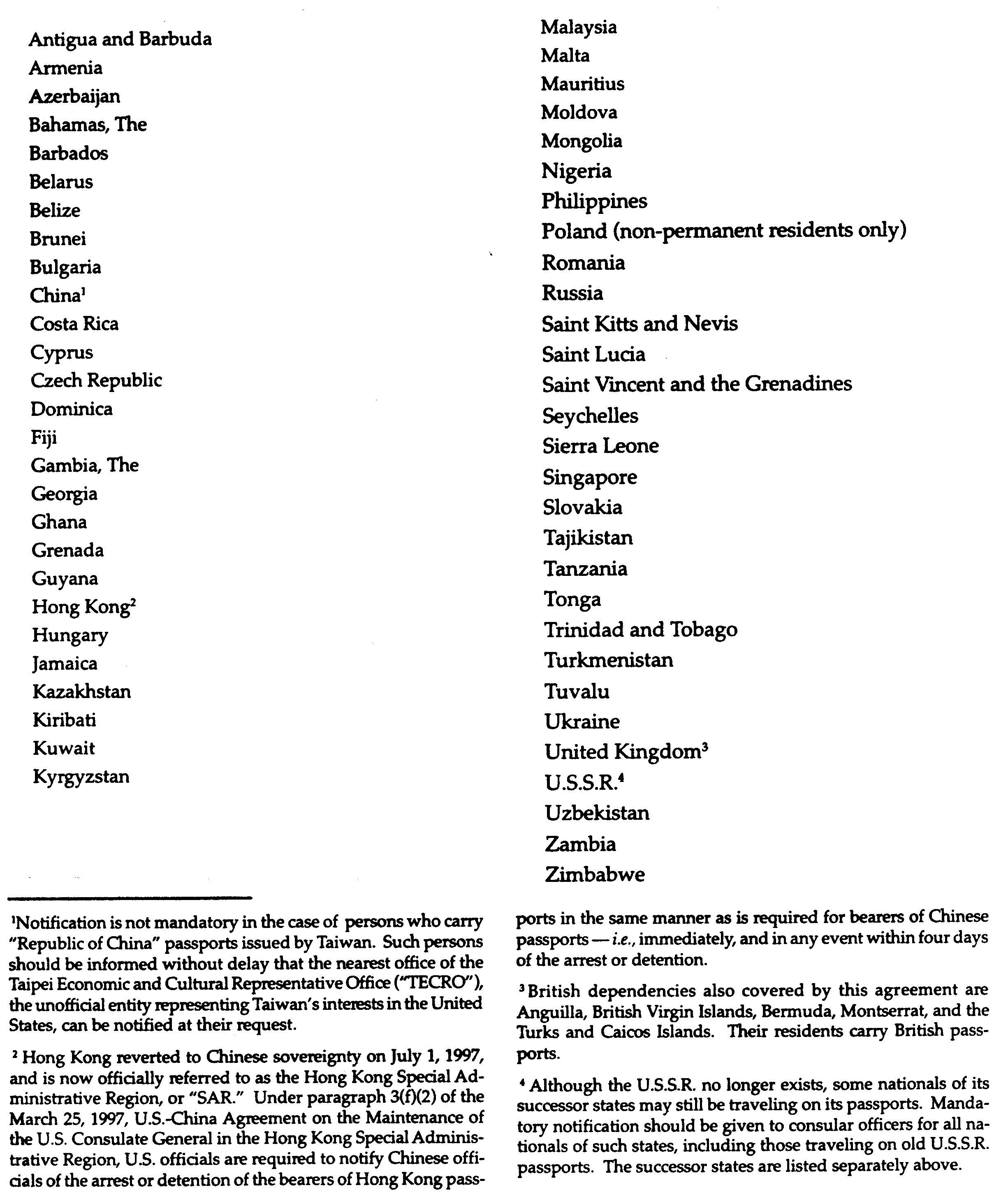
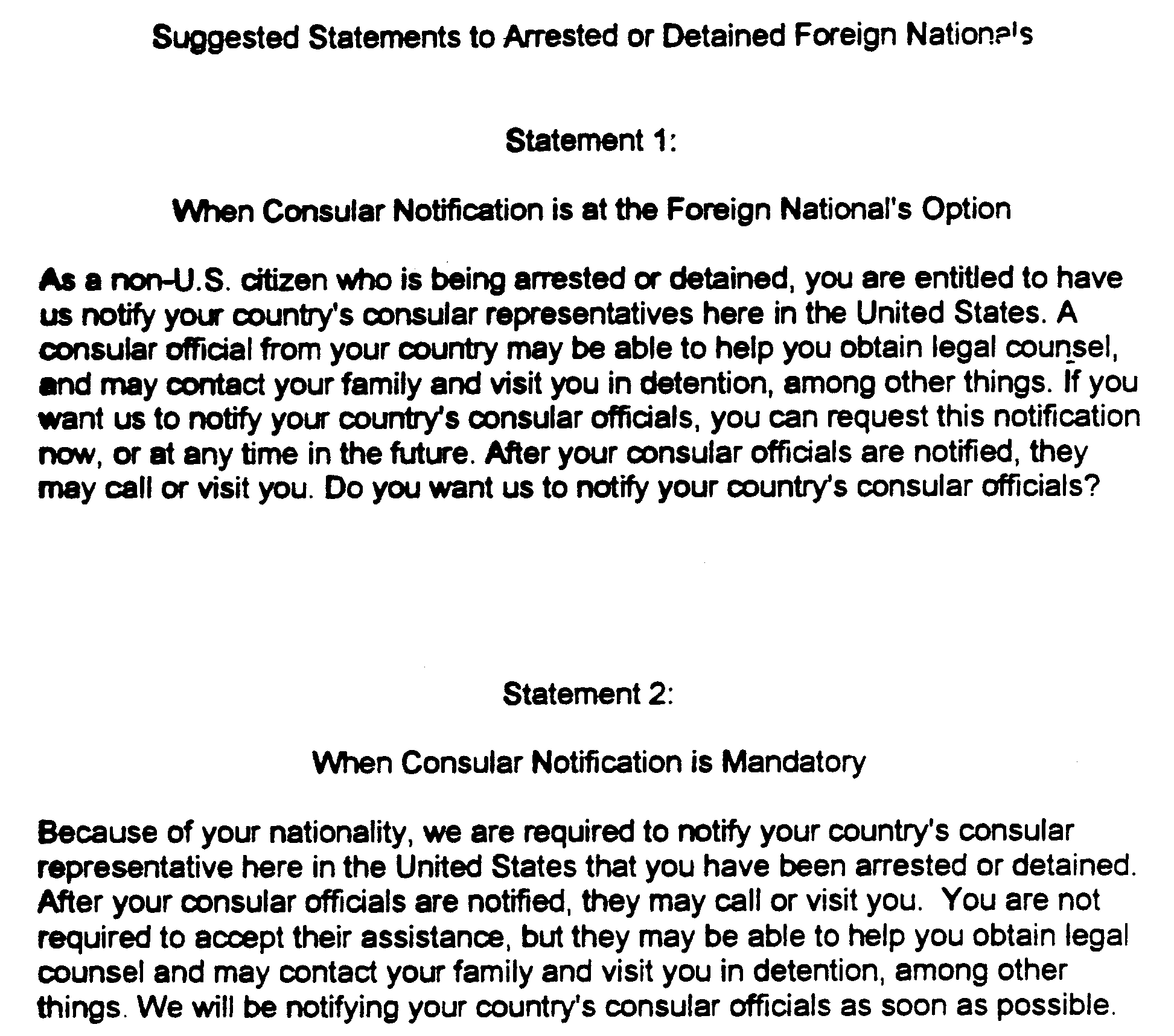
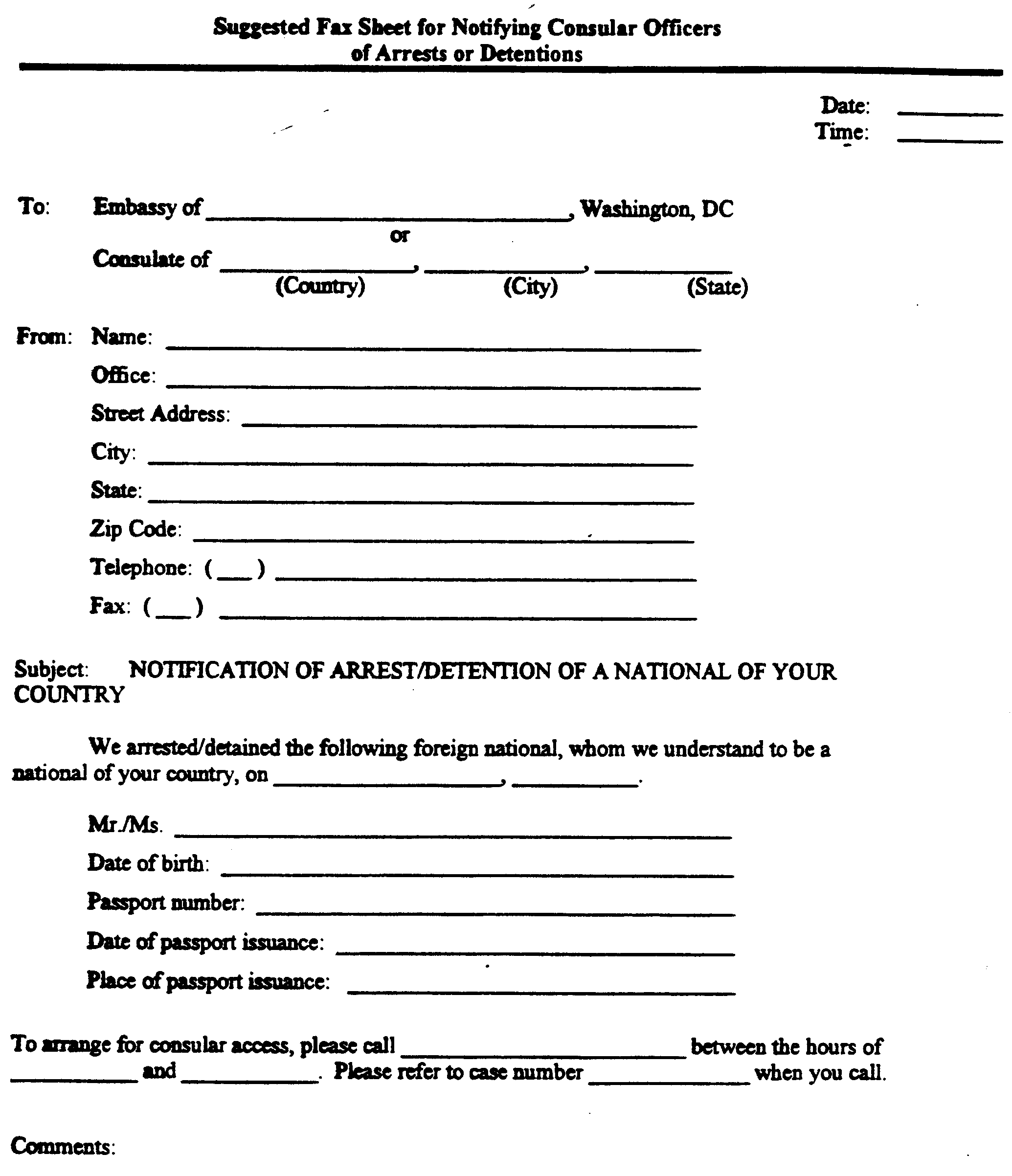
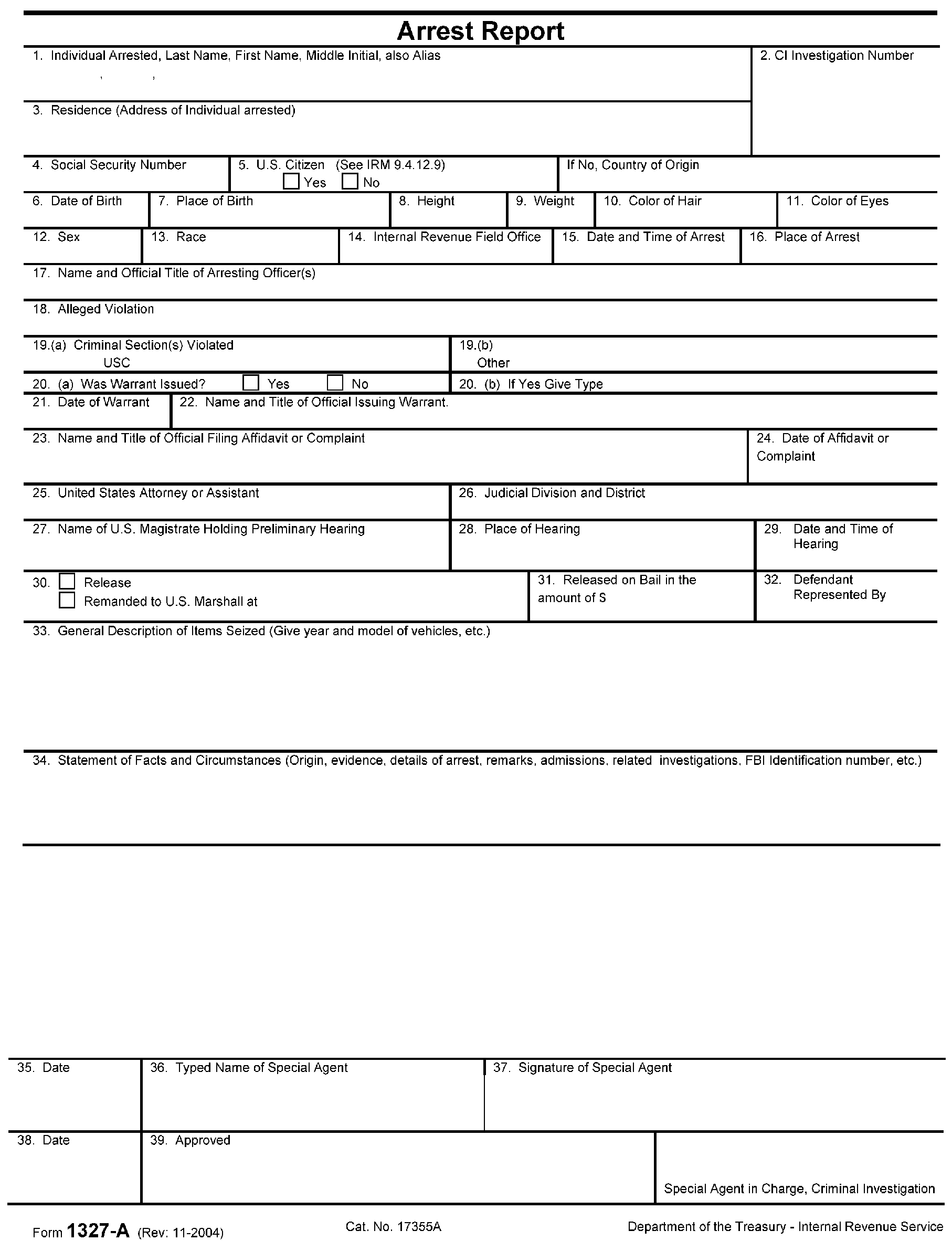
| Fax to USNCB, (202) 616-8400, within 24-hours of requesting Fugitive Location |
| (diffusion). |
| In consideration of transmission by INTERPOL -- US National Central Bureau (USNCB) of an INTERPOL request for fugitive location (diffusion) or red notice (International Wanted Notice) for UNDERSCORE , F/N UNDERSCORE , (DOB UNDERSCORE , POB UNDERSCORE ) via INTERPOL's dedicated, world-wide telecommunications system, and |
| On behalf of [name of prosecutor's office] UNDERSCORE , if the fugitive is located abroad in a country that can extradite I hereby agree: |
| 1. That the US Department of Justice, Office of International Affairs (OIA), (202) 514-0000, after hours OIA Duty Attorney (202) 514-5000 (DOJ 24-hour Command Center); telefax (202) 514-0080 shall immediately transmit a request for the fugitive's provisional arrest with a view toward extradition, or for the fugitive's return to the United States by other legal means. |
| 2. To submit a draft request for the fugitive's extradition to OIA within 10 days of the fugitive's provisional arrest or as agreed with the responsible OIA attorney (extradition request normally includes prosecutor's and agent's affidavits; certified copies of charging document(s) (or judgment of conviction) and arrest warrant(s); witness statement(s); fugitive's photograph and fingerprints.) |
| 3. To pay all costs of extradition (translation of extradition request if necessary, round-trip air fare and per diem for two US Marshals or one Marshal and one state/local official; fugitive's one-way air fare; foreign attorney fees if applicable). |
| 4. To inform the USNCB and OIA immediately in writing: |
| (a) if the fugitive is apprehended in (or returned to) the United States; |
| (b) if the NCIC entry is cancelled; |
| (c) if the charges are dropped; |
| (d) if this office will not prosecute this case for any reason, or |
| (e) if this office will not extradite this fugitive internationally; and |
| (f) if the prosecutor 24-hour contact information (below) changes. |
| IF there is as yet no application for a red notice, the investigator will forward one ASAP to the INTERPOL -- US National Central Bureau with copies of the arrest warrant (warrant number and judge's name legible); charging document(s) (or judgment of conviction); copies of identity documents or confirmations of identity document numbers if possible; fugitive's photographs and fingerprints; and executed original of this Agreement. |
| Prosecutor authorizing extradition: | Backup prosecutor: |
| Name: | Name: |
| Signature: | |
| Title: | Title: |
| Name of office: | |
| Address: | |
| Phone: | Phone: |
| Beeper/Cell phone: | Beeper/Cell phone: |
| Home phone: | Home phone: |
| Fax: | Fax: |
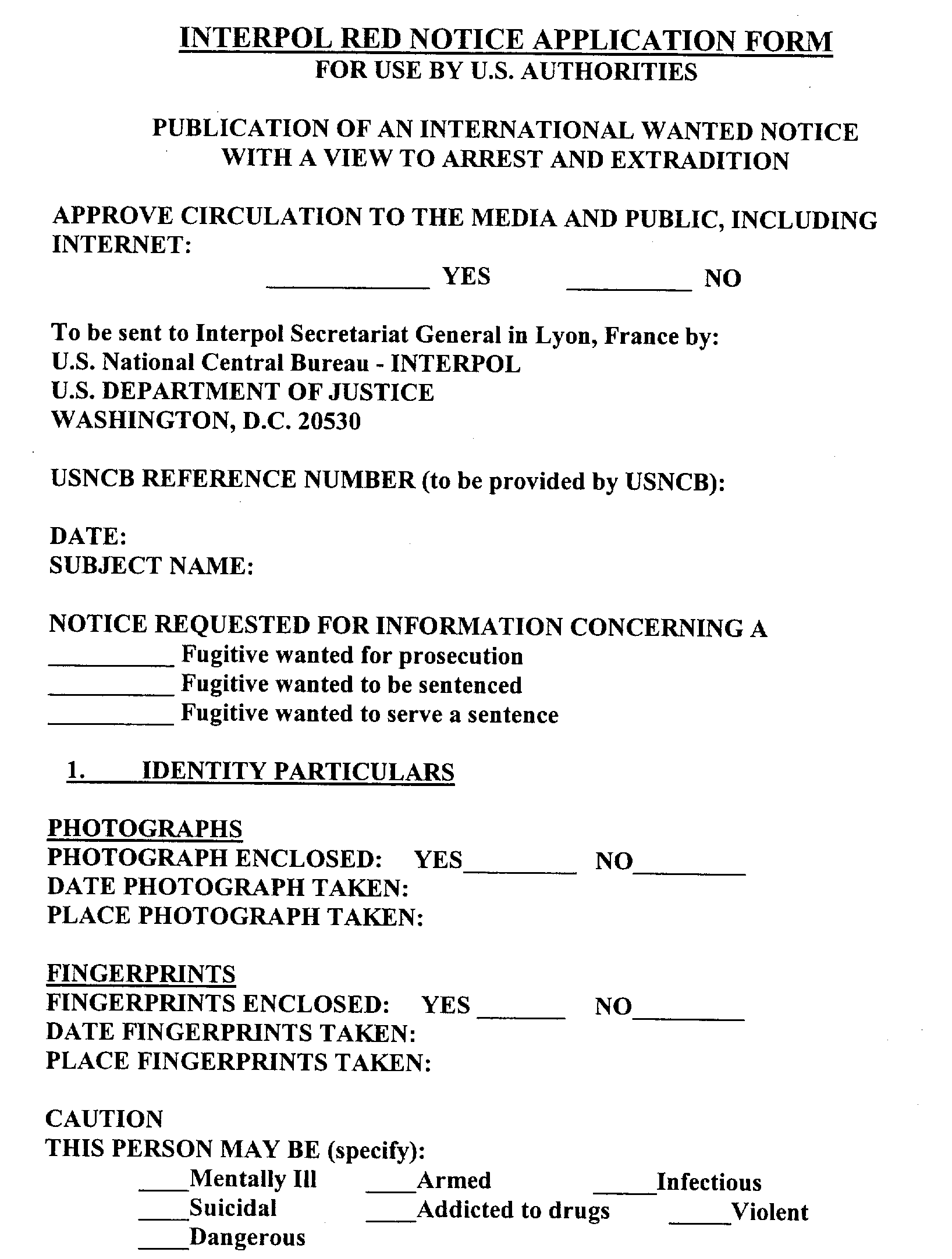
Please click here for the text description of the image.
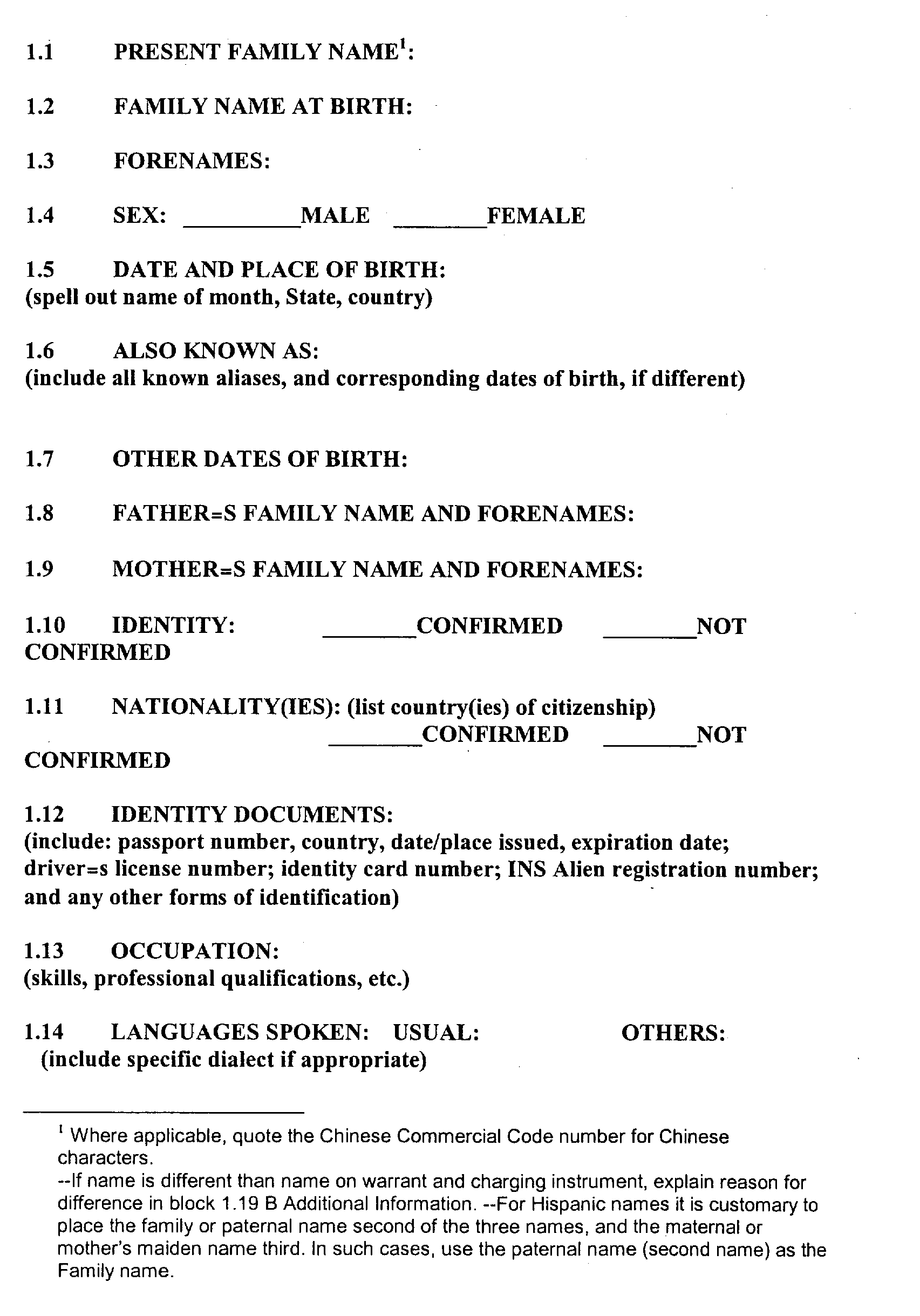
Please click here for the text description of the image.
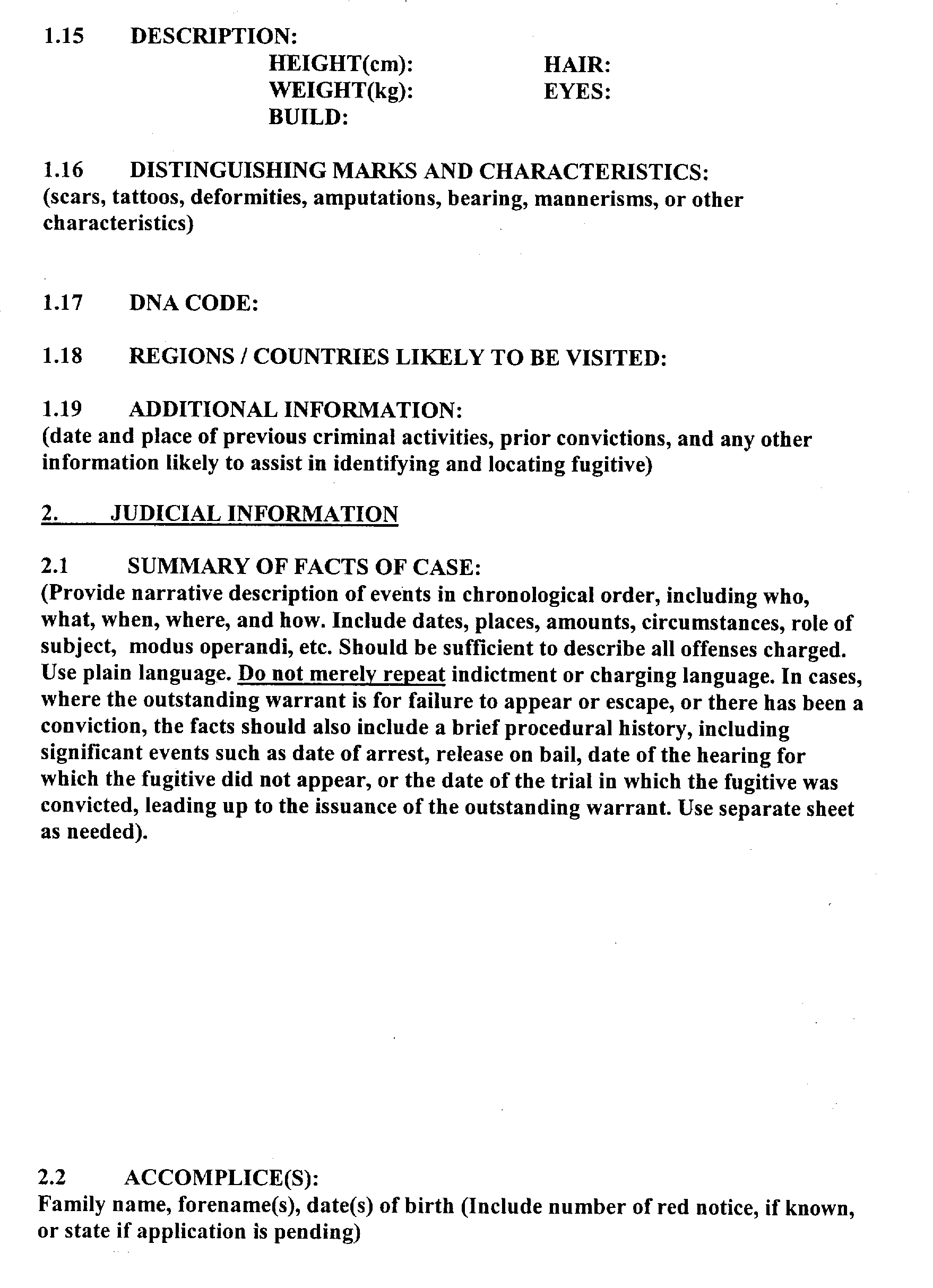
Please click here for the text description of the image.
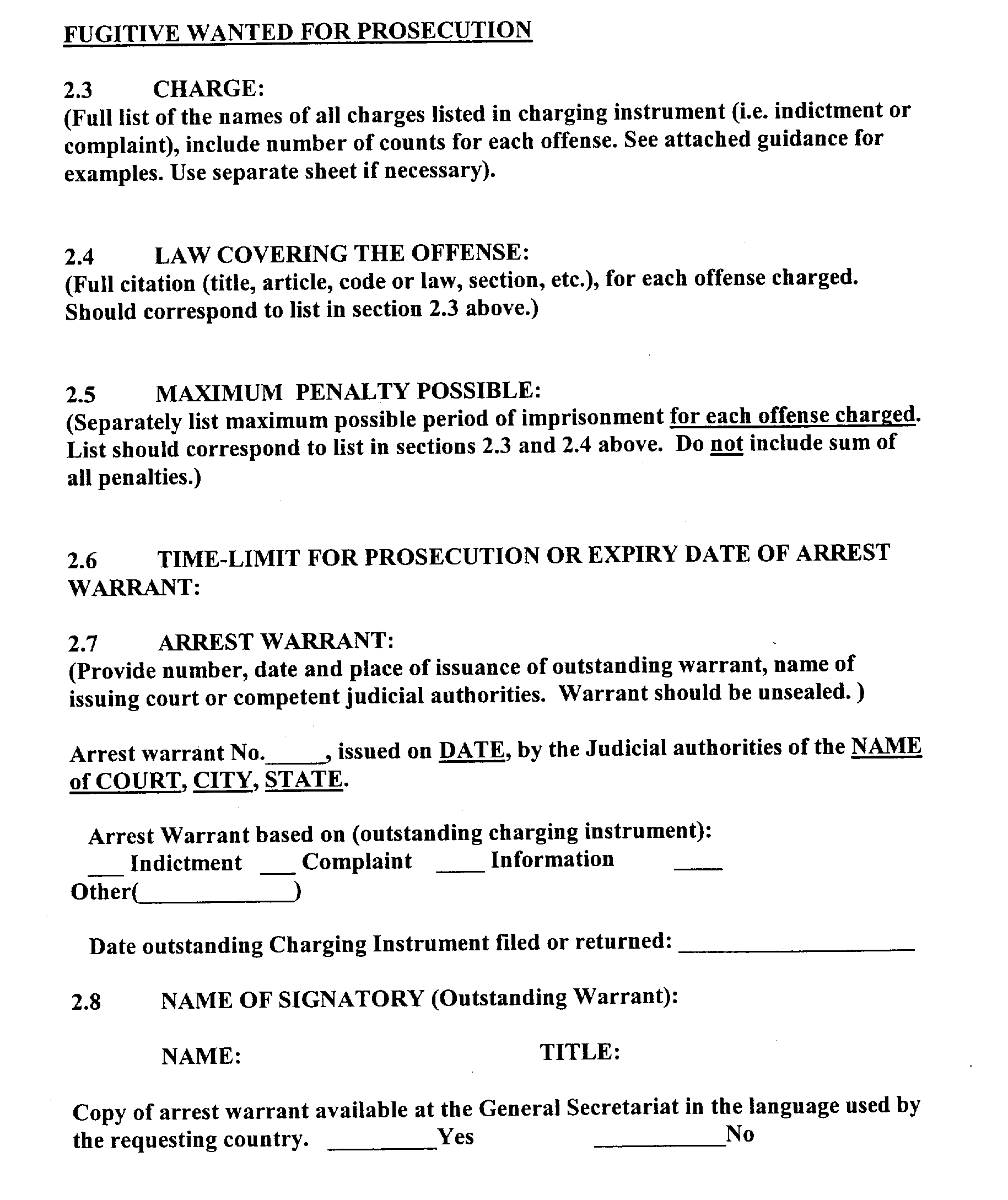
Please click here for the text description of the image.
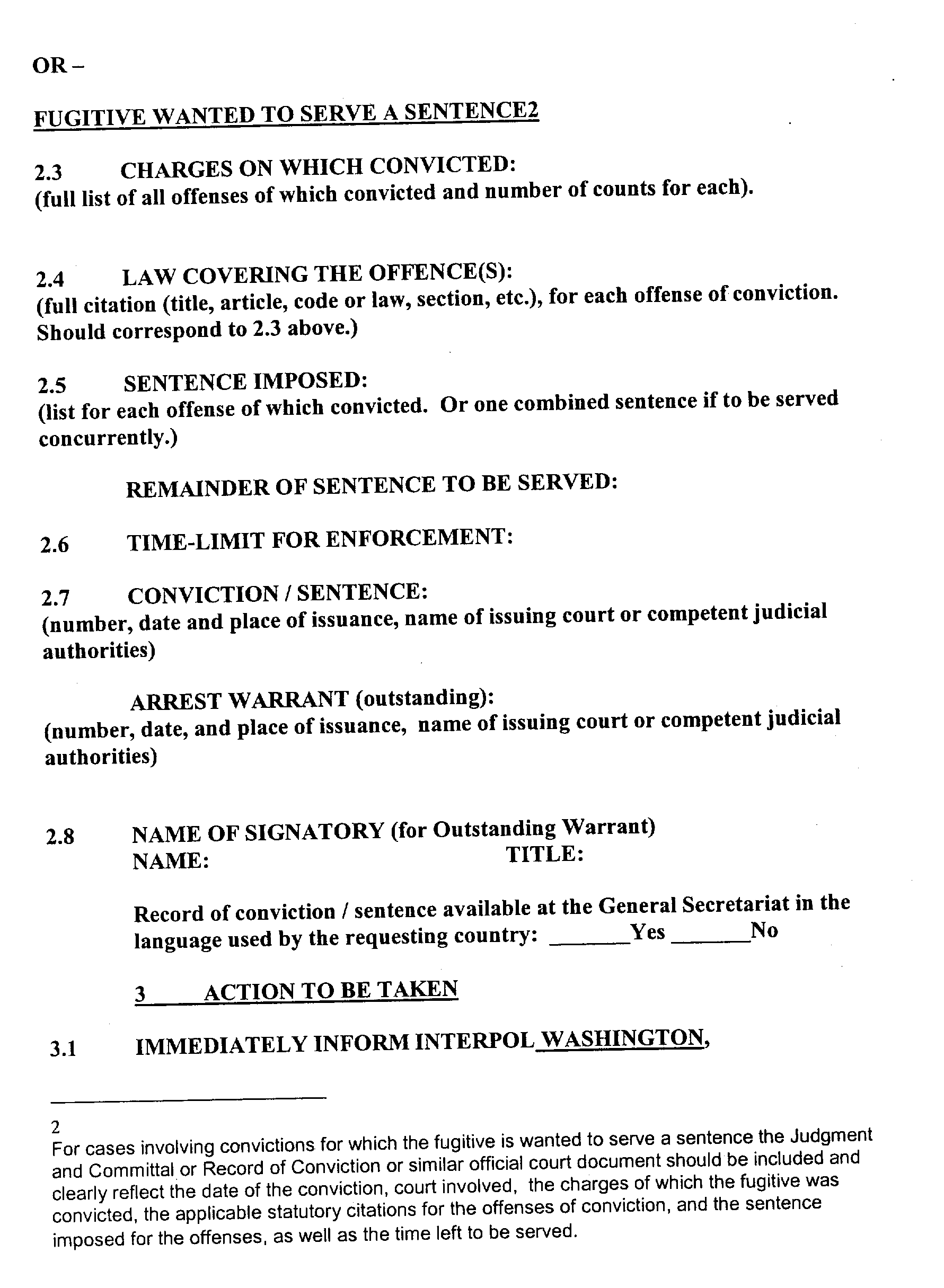
Please click here for the text description of the image.
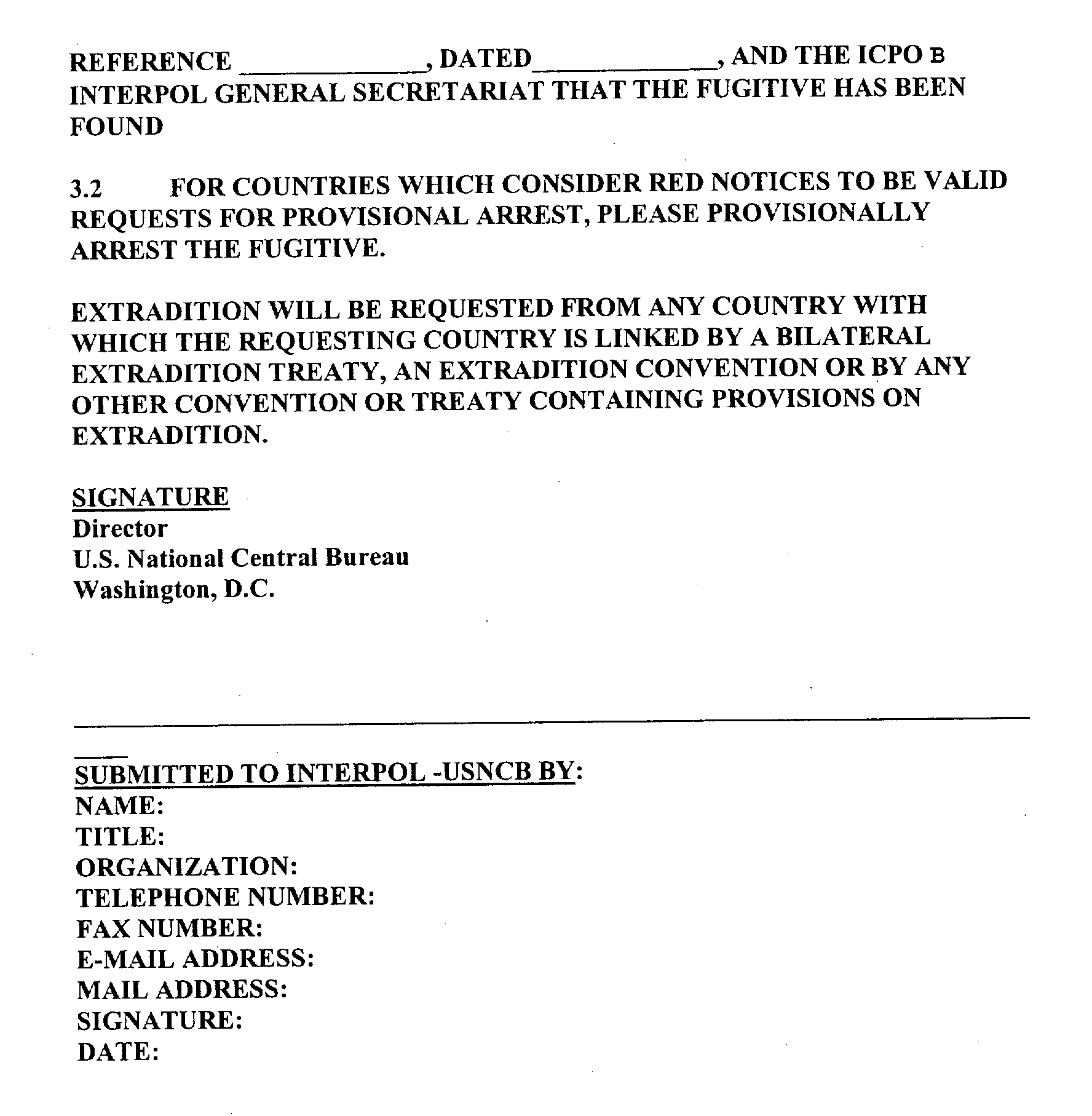

 )
o https:// significa que usted se conectó de forma segura a un sitio web .gov. Comparta información sensible sólo en sitios web oficiales y seguros.
)
o https:// significa que usted se conectó de forma segura a un sitio web .gov. Comparta información sensible sólo en sitios web oficiales y seguros.

